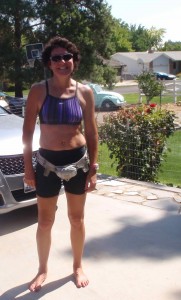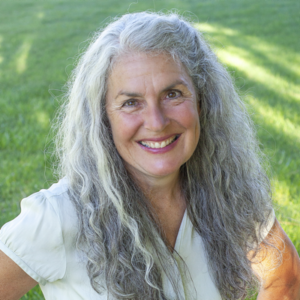It was just over a week until the Emmett Sprint Triathlon. It would be my 3rd official sprint triathlon, the 4th sprint triathlon I had trained for. Before graduating to the sprint length, I had tried two well spaced (by a few years) mini-triathlons in an indoor setting.
I had completed my first half marathon foot race in the spring of this year (a couple of months ago), then moved right into brick training for the triathlon. I felt physically strong, but I was still apprehensive about the coming triathlon.
For one thing, my 10 year post-meniscus repair knee was acting up unusually. I had had to cut back some on my degree of training and was feeling less prepared than I had a month previously. My husband, who is my primary coach, saw all of this and prescribed a pre-tri trial exactly one week before the actual event.
I thought he was nuts. One week before the race? When he had recommended that before my first sprint triathlon, we had barely squeezed it in 2 weeks before the event and it took me nearly that long to recover!
But that is why we have coaches. They are able to objectively evaluate. The truth is, that even for that first pre-race trial 3 years ago, when I thought I might die during the effort, it helped me mentally. I probably could not have done it sooner than that 2 weeks ahead of time because I wasn’t as strong, and I DID recover fine in time for the actual event.
What he was thinking this time around was
- that I had been building a base of training for about 3 years now
- that I still had quite a bit of endurance from the half marathon training
- with that advantage, I had moved into longer duration brick training than I had done for the other triathlons
- so that almost all of my brick training (4-5 days a week) had been triathlon length in time
So, he told me to relax. It was not about the time. It was an exercise in proving that I could make the distances in each event, back-to-back. He said I would be encouraged and I would have fun.
I tried to imitate race conditions as reasonably as I could. I made my check list of supplies and set up transition points in the garage. I tried to eat about the same time as I would in relation to the race AND, importantly, the same food. I also aimed for doing the trial triathlon at the same time of day that the race would be held.

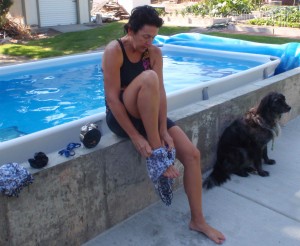
Humorously, the pool heater in my Tuff Pool had been left a bit low the night before, so I was treated to a cool water temperature, similar to what the reservoir will be. This meant I “got to” wear my full body swim suit and practice taking it off after the swim during transition 1 (T1). The pool is still in the shade of trees that time of day, so there was no morning sun to warm me up, but I was comfortable once I started swimming.
I swam 15 minutes without stopping in my Fastlane current. This should be at least 3 minutes longer than the swim during the triathlon, based on my 12 minute time last year. My husband adjusted the speed for me a little while I was swimming, which is the first time I have tried that approach. He tried to judge whether or not I was gaining or falling back in the current. I think it ended up a little faster than I usually swim, but I made it.
I don’t remember being chilled at all after the swim last year, but for some reason I was really concerned about it this year. It may partially be because I have lost a few pounds, so chill more easily in general. However, a quick pat dry and just the movement to get through T1 kept me warm enough.
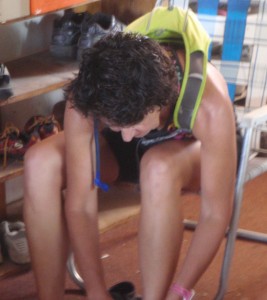
I had forgotten my socks, so had to run downstairs quickly for them, but everything else went smoothly for getting on the bike. The camelbak was plump with my lemonade drink. It also had repair supplies and my phone in the pockets. The main difference from the actual triathlon was that I used a chair to sit in to get my shoes on and there were no other transitioning triathletes around me adding nervous energy to the affair.
This was my first outdoor ride with my new bike seat, so I was pleased to find that it was perfect. I tried to find a balance between a good effort pedaling and not straining at the bit. The wind was pretty stiff on the way back to home base, but I enjoyed the whole bike ride. Total 12 mile bike ride: 44 minutes, and that included a few moments at the start to adjust my rear view mirror attached to my sunglasses.
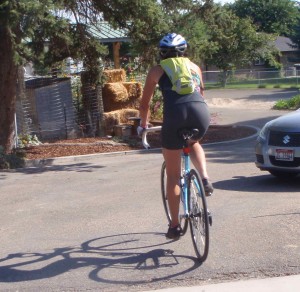
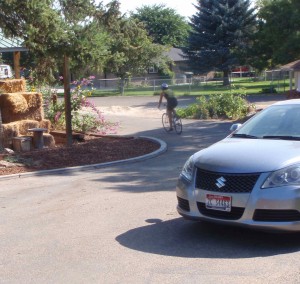
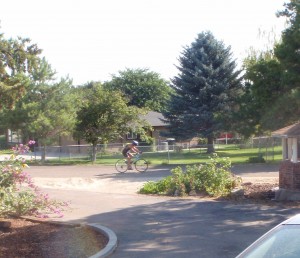
But the final test would be adding the run. All during the bike ride, I prepared myself mentally for the running to feel plodding and heavy. Even during my training runs with only the bike first, the run was noticeably more difficult than just going out for a run with nothing else first. With the pull back due to the knee, I was especially skeptical that it would go well.
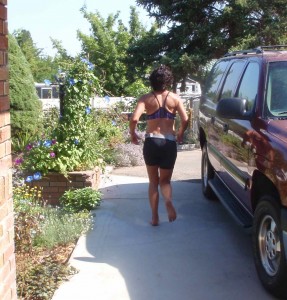
T2 is pretty easy when running is going to be done without foot wear. I did take time to put a hip belt on so I would have my phone. This is something I won’t worry about during the event, since there will be people everywhere if I end up needing help. I also took one last drink of my lemonade.
My main goal with the run, was to keep it light, so as not to stress out my knee. Beginning barefooted on fairly sharp asphalt definitely helped keep me prancing, so to speak. Somehow, the combination of being warmed up from the bike ride and focusing on a light, springy step got me off to a comfortable pace that ended up being on the fast side of my range.
When I saw how my first mile went, I wondered if I would fade soon, but I didn’t. My run was about 40 seconds faster than it had been during the triathlon last year. That was certainly encouraging. Run of 3.1 miles in 24:49.
This has happened to me repeatedly during training runs. When I just relaxed, I ran faster with less effort and had more fun. Of course, I believe that running with bare feet has a lot to do with this, too.
So, what did I learn?
- I can go the distance and without feeling like I will expire at the end. I don’t need to push myself into any scary zones to get it done.
- I don’t need to try to rush through transitions. Rushing is more likely to make me fumble and take longer. Having things set up and simple is more important.
- Being intense will not necessarily help me go faster, for any of the legs of the triathlon. I will do best if I race within my training limits.
- There are advantages to training for a half marathon a little bit before training for a spring triathlon.
- Training for triathlons in subsequent years builds me up in ways that can’t be done in just one year.
- These were all things that my husband had tried to explain to me, but going through the process helped me to know it personally. There is no verbal encouragement that can take the place of a trial triathlon experience.
